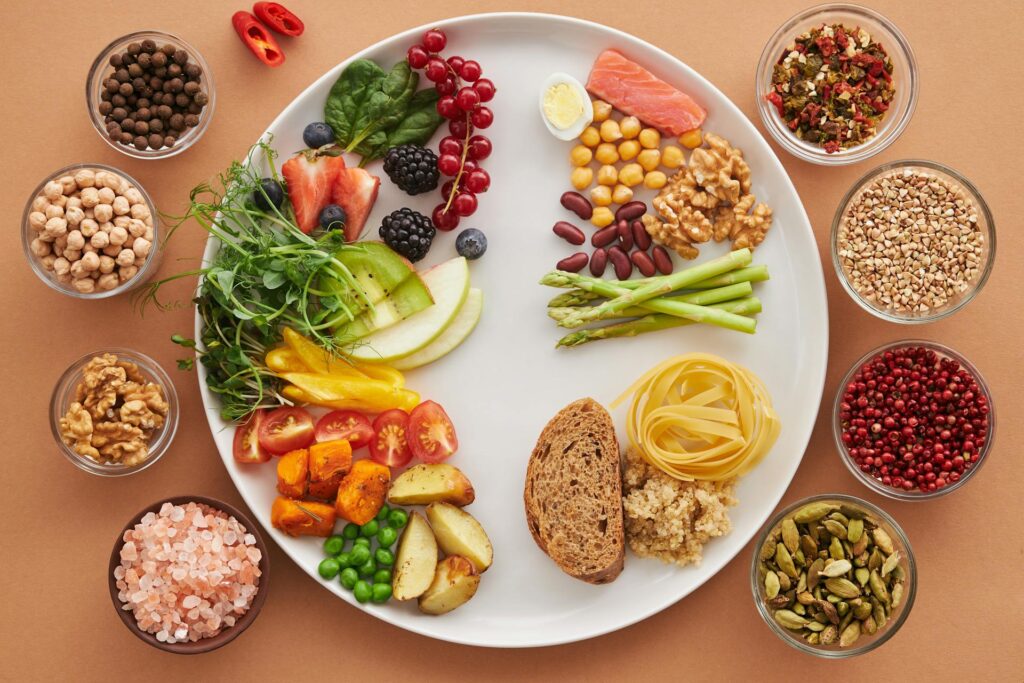Top Diet Trends in 2024: Gone are the days of fad diets promising quick fixes and unrealistic expectations. In 2024, the conversation surrounding diet and nutrition has undergone a refreshing transformation. Today, the focus is on nourishing your body for long-term health and well-being. This shift translates into two key trends: the quality of the food you consume and the timing of your meals. Let’s delve deeper into these trends and explore the exciting possibilities they hold.

Table of Contents
Diet Trends in 2024: #1 Embracing Nutrient-Rich Powerhouses
The Diet Trends in 2024 emphasizes filling your plate with a symphony of colorful and nutrient-dense foods. Here, we’ll break down the key dietary components that are taking center stage:
- The Powerhouse Produce: Fruits and vegetables are the undisputed champions of a healthy diet. They are brimming with essential vitamins, minerals, and fiber. Aim to incorporate a rainbow of colors on your plate. Deep orange carrots provide beta-carotene for healthy vision, while leafy greens like kale are loaded with vitamins A, C, and K. Don’t be afraid to experiment! Explore the vibrant world of fruits and vegetables – from antioxidant-rich berries to cruciferous powerhouses like broccoli and cauliflower.
- Fiber Fantastic: Include plenty of fiber in your diet. It’s a game-changer for digestion, gut health, and weight management. Fiber keeps you feeling fuller for longer, reducing cravings and preventing overeating. Fruits, vegetables, and whole grains are all excellent sources of fiber.
- Going Whole Grain: Ditch the refined grains and embrace the power of whole grains! Opt for whole-wheat bread, brown rice, and quinoa instead of their refined counterparts. Whole grains offer a sustained release of energy, complex carbohydrates, and essential nutrients often lost during processing.
Healthy Fats: Friend, Not Foe
For years, fat has been demonized in the dieting world. However, the tide is turning. We now understand that incorporating healthy fats into your diet is crucial for overall health:
- The Magic of Monounsaturated Fats: Avocados, nuts like almonds and cashews, and olive oil are rich sources of monounsaturated fats. These fats promote heart health, may aid in weight management by increasing satiety, and contribute to a feeling of fullness.
- Omega-3 Power: Fatty fish like salmon, tuna, and sardines are packed with omega-3 fatty acids. These essential fats are crucial for brain function, reducing inflammation, and promoting heart health. Aim to incorporate at least two servings of fatty fish into your weekly diet.
Lean Protein for Building Blocks:
Protein is a vital macronutrient that plays a critical role in building and repairing tissues, maintaining muscle mass, and keeping you feeling satisfied after meals. Here’s how to incorporate lean protein sources into your diet:
- Variety is Key: Include a variety of lean protein sources in your diet, such as chicken, fish, beans, lentils, and tofu. Experiment with plant-based protein options like tempeh and seitan for a meatless twist.
The Mediterranean Diet: A Delicious Journey Through Time
The Mediterranean diet consistently ranks at the top of “best overall diet” lists for a reason. This dietary pattern, inspired by the traditional eating habits of countries bordering the Mediterranean Sea, offers a delicious and sustainable approach to healthy eating:
- Beyond Just Hummus: While hummus is a delicious staple, the Mediterranean diet is a vibrant exploration of flavors. Think Greek yogurt parfaits with berries and granola for breakfast, or a lunch salad bursting with chickpeas, feta cheese, olives, and a lemon vinaigrette dressing. Dinner can be a light and flavorful dish of grilled fish with roasted vegetables.
- Seasonal and Local: Embrace the bounty of your local farmers market! The Mediterranean diet encourages incorporating seasonal fruits and vegetables, ensuring freshness, supporting local agriculture, and reducing your environmental footprint.
The Flexitarian Diet: Embracing Plants with Flexibility
The flexitarian diet is a perfect fit for those who want to incorporate more plant-based meals without completely eliminating meat. It offers a flexible approach to healthy eating, allowing you to reap the benefits of a plant-forward diet while still enjoying occasional animal products. Here’s how to embrace the flexitarian lifestyle:
Meatless Mondays (and Tuesdays!):
The flexitarian approach encourages incorporating more plant-based meals throughout the week. This doesn’t have to be an all-or-nothing approach. Start by dedicating a few days each week to vegetarian or vegan meals. Explore the vast world of vegetarian and vegan recipes! There are countless delicious and satisfying options online and in cookbooks. You can also try a “meatless makeover” on your usual recipes. Simply skip the meat in your stir-fry and add extra tofu or lentils for a plant-based protein boost.
Mindful Meat Portions:
When you do incorporate animal protein, focus on lean cuts and moderate portions. Prioritize quality over quantity. A small piece of grilled chicken or salmon can add variety and protein to your plate without compromising your dietary goals. Consider these tips for mindful meat portions:
- Palm-sized portions: Imagine your palm – that’s roughly the size a serving of lean protein should be.
- Focus on variety: Choose different lean protein sources throughout the week, such as chicken, fish, beans, and lentils.
- Pair with plenty of vegetables: Fill half your plate with colorful vegetables to ensure a balanced and filling meal.
Plant-Based Protein Powerhouses:
Beans, lentils, chickpeas, and tofu are all excellent sources of plant-based protein. They are filling, provide essential nutrients like iron and fiber, and can be incorporated into a variety of delicious dishes. Explore these ideas to embrace plant-based protein powerhouses:
- Hearty Vegetarian Chili: This classic comfort food is a perfect example of a protein-packed vegetarian dish. Black beans and kidney beans provide protein and fiber, while vegetables like corn and tomatoes add flavor and nutrients.
- Lentil Soup with Greens: Lentils are another excellent source of plant-based protein. Create a warming and healthy soup by combining lentils with vegetables like carrots, celery, and spinach.
- Tofu Scramble: Craving breakfast eggs? Tofu scramble is a delicious and versatile vegan option. Crumble firm tofu and pan-fry it with turmeric, nutritional yeast, and your favorite vegetables to create a satisfying and protein-rich breakfast scramble.
Remember, the beauty of the flexitarian diet lies in its flexibility. Experiment, find what works for you, and enjoy the journey towards a healthier and more sustainable way of eating!
Diet Trends in 2024: #2 Exploring the Rhythms of Eating: Intermittent Fasting
Intermittent fasting (IF) takes a different approach to healthy eating. It focuses on when you eat, not necessarily what. There are various approaches to IF, but the most popular method involves restricting your eating window to 8 hours daily and fasting for the remaining 16 hours.
Potential Benefits of Intermittent Fasting:
- Weight Management: By limiting your daily eating window, you may consume fewer calories overall, potentially leading to weight loss. Studies suggest that IF can be an effective tool for weight management, especially when combined with a healthy diet.
- Metabolic Boost: Research suggests that IF may improve insulin sensitivity and blood sugar control, promoting a healthier metabolism. This can lead to better blood sugar management and potentially reduce the risk of type 2 diabetes.
- Cellular Repair: Intriguing research suggests that fasting may promote cellular repair processes within the body, potentially contributing to overall health benefits like reducing inflammation and improving cellular health.
Popular Intermittent Fasting Schedules:
There’s no one-size-fits-all approach to IF. Here are some popular schedules for beginners:
- 16:8 Method (Leangains): This is the most common method, involving an 8-hour eating window and a 16-hour fasting window. For example, you could eat between 10 am and 6 pm, and fast for the remaining 16 hours.
- 14:10 Method: Similar to 16:8, but with a slightly shorter fasting window (14 hours) and a 10-hour eating window. This may be a good starting point for those new to IF.
- 5:2 Method: This approach involves eating normally for 5 days of the week and restricting calories to 500-600 on 2 non-consecutive days. While it may be effective for weight management, consulting with your doctor before trying is crucial.
Important Considerations for Intermittent Fasting:
- Listen to Your Body: Don’t push yourself too hard. Intermittent fasting is not a competition. If you feel excessively hungry or lightheaded during your fasting window, adjust your approach or consult a doctor. There’s no shame in starting with a shorter fasting window and gradually increasing the duration as your body adjusts.
- Hydration is Key: Drinking plenty of water throughout the day is crucial during fasting periods. Water helps to flush toxins from the body, keeps you feeling full, and supports overall health. Aim to consume water regularly throughout the day, even during your fasting window.
- Not for Everyone: Intermittent fasting may not be suitable for everyone, especially those with certain health conditions like diabetes, eating disorders, or a history of disordered eating. It’s vital to consult with your doctor before starting IF to ensure it’s safe and appropriate for you.
Finding Your Perfect Plate: Combining these Diet Trends in 2024 for Long-Term Success
The beauty of these trending diets lies in their flexibility and focus on overall well-being. You can combine elements from both trends to create a personalized approach that fits your lifestyle and preferences. Here are some tips:
- Start Small: Don’t overwhelm yourself with drastic changes. Begin by incorporating more vegetables into your meals or trying a meatless Monday. Gradually integrate new habits for sustainable success.
- Explore New Flavors: Embrace the world of plant-based proteins and healthy fats! Experiment with vegetarian and vegan recipes, or discover the versatility of lentils and chickpeas. There’s a whole world of delicious and nutritious food waiting to be explored.
- Listen to Your Body: Pay attention to your body’s hunger cues. Don’t restrict yourself to the point of feeling deprived. Aim for balanced meals that leave you feeling satisfied and energized.
- Consult a Doctor or Registered Dietitian: A doctor or registered dietitian can help you create a personalized plan that considers your health goals, existing medical conditions, and lifestyle. They can also provide guidance on portion control, nutrient deficiencies, and supplements if needed.
Diet Trends in 2024 Remember: Consistency is Key
The most effective diet is the one you can stick with in the long term. Don’t get discouraged by occasional slip-ups. View them as learning experiences and recommit to your goals. By embracing these trends and focusing on nourishing your body, you can cultivate a healthy relationship with food and achieve your long-term health and wellness goals. Happy eating!
More Reads:
Unlock the Secrets of the Mediterranean Diet: Key Ingredients and Cooking Tips


